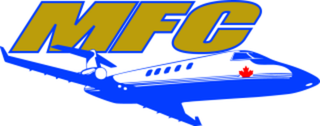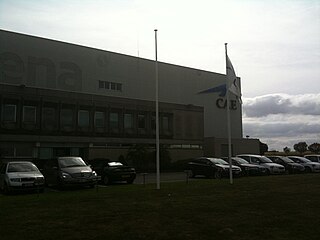
An aircraft pilot or aviator is a person who controls the flight of an aircraft by operating its directional flight controls. Some other aircrew members, such as navigators or flight engineers, are also considered aviators, because they are involved in operating the aircraft's navigation and engine systems. Other aircrew members, such as drone operators, flight attendants, mechanics and ground crew, are not classified as aviators.

A stick shaker is a mechanical device designed to rapidly and noisily vibrate the control yoke of an aircraft, warning the flight crew that an imminent aerodynamic stall has been detected. It is typically present on the majority of large civil jet aircraft, as well as most large military planes.
In aviation, a controlled flight into terrain is an accident in which an airworthy aircraft, under pilot control, is unintentionally flown into the ground, a mountain, a body of water or an obstacle. In a typical CFIT scenario, the crew is unaware of the impending disaster until it is too late. The term was coined by engineers at Boeing in the late 1970s.

CAE Inc. is a Canadian manufacturer of simulation technologies, modelling technologies and training services to airlines, aircraft manufacturers, healthcare specialists, and defence customers. CAE was founded in 1947, and has manufacturing operations and training facilities in 35 countries. In 2017, the company's annual revenue was CAD $2.705 billion.

The Extra Flugzeugbau EA300 is a two-seat aerobatic monoplane capable of Unlimited category competition. It was designed in 1987 by Walter Extra, a German aerobatic pilot, and built by Extra Flugzeugbau.
NATO Flight Training in Canada (NFTC) is a military flight training program for NATO and allied air forces provided by the Canadian Forces.
Aircraft upset is a dangerous condition in aircraft operations in which the flight attitude or airspeed of an aircraft is outside the normal bounds of operation for which it is designed. This may result in the loss of control (LOC) of the aircraft, and sometimes the total loss of the aircraft itself. Loss of control may be due to excessive altitude for the airplane's weight, turbulent weather, pilot disorientation, or a system failure.
A stick pusher is a device installed in some fixed-wing aircraft to prevent the aircraft from entering an aerodynamic stall. Some large fixed-wing aircraft display poor post-stall handling characteristics or are vulnerable to deep stall. To prevent such an aircraft approaching the stall the aircraft designer may install a hydraulic or electro-mechanical device that pushes forward on the elevator control system whenever the aircraft's angle of attack reaches the pre-determined value, and then ceases to push when the angle of attack falls sufficiently. A system for this purpose is known as a stick pusher.

Falcon Field is in an airport located in Maricopa County, Arizona. It was originally built 6 miles northeast of Mesa, which owns it. However, it is now within city limits. The National Plan of Integrated Airport Systems for 2017–2021 categorized it as a reliever airport. Scheduled service to Bullhead City on Western Express Air ended in January 2007.

The Slingsby T67 Firefly, originally produced as the Fournier RF-6, is a two-seat aerobatic training aircraft, built by Slingsby Aviation in Kirkbymoorside, Yorkshire, England.

The Moncton Flight College (MFC) is a pilot training school based at the Greater Moncton International Airport (CYQM) in Dieppe, New Brunswick, Canada. They have a second location at the Fredericton International Airport (YFC) in Lincoln, NB. In a year, MFC has the capacity to train 450 students between the Moncton and Fredericton Campus. Currently the Moncton Campus offers domestic and international programs with a 260-student capacity and a staff of 55. The Fredericton campus is primarily for Chinese student training with some modular based flight training and has a capacity of 190 students and employs 70 people. Both of the campuses have on-site kitchens and residences. MFC is the largest private flight school in Canada. It is also one of six, out of 150 schools in Canada, to be given integrated status. The college has trained over 20,000 pilots from approximately 70 countries since 1929. MFC has an approved FTU, ATO and AMO from Transport Canada and also has CAAC (China) approval.

ADC Airlines Flight 053 (ADK053) was a scheduled passenger flight operated by ADC Airlines from Nigeria's capital of Abuja to Sokoto. On 29 October 2006, the Boeing 737-2B7 crashed onto a corn field shortly after take-off from Nnamdi Azikiwe International Airport in Abuja, killing 96 out of 105 people on board.

FedEx Express Flight 14 was a scheduled cargo flight from Singapore to Newark, New Jersey, via Malaysia, Taiwan, and Alaska. On July 31, 1997, the aircraft flying this route crashed during landing on its final segment at Newark International Airport (EWR), inverting and catching fire, injuring all five people on board.
CAE Oxford, part of CAE Inc., is an ab initio flight training network. It provides integrated aviation training and resourcing services. Professional airline pilots have been trained at the Oxford Aviation Academy flight school since 1961.

CAE Oxford Aviation Academy Brussels - Sabena Flight Academy is an aviation training organisation created in 1953, and located in Steenokkerzeel (Belgium). The school is now part of CAE Global Academy. The training is performed in Brussels, in Mesa at CAE Oxford Aviation Academy Phoenix . Sabena Flight Academy is one of the oldest airline transport pilot schools in Europe.

The Grob G 120TP is a two-seat turboprop training and aerobatic low-wing aircraft with a composite airframe, built by Grob Aircraft. It is based on the Grob G 120A training aircraft and has been developed for military and civil pilots training. It has a retractable tricycle landing gear and a low tailplane.
Link Aviation Devices was a manufacturer of aircraft simulators. The company is most notable for inventing the Link Trainer, and is credited with starting the flight simulator industry. It is currently a subsidiary of CAE Incorporated.

CAE Phoenix is an aviation school owned by CAE and located in Mesa at Falcon Field Airport. A former subsidiary of Sabena Flight Academy, the school has previously trained students including those of Air Algérie, SFA, Nationale Luchtvaartschool (NLS), Turkish Airlines, Shenzhen Airlines, EVA Air, British Airways, Southwest Airlines, Japan Airlines, jetBlue, American Airlines, Emirates, EasyJet, CityJet, IndiGo, Aeromexico and AirAsia.

Breda International Airport is a small general aviation airfield located next to the A58 motorway on the outskirts of Bosschenhoofd, a village in the municipality of Halderberge in the province of North Brabant in the Netherlands. It is located 2 NM southwest of Hoeven, 7.5 NM west from Breda and 4 NM east-northeast of Roosendaal.
Upset Prevention and Recovery Training (UPRT) is a combination of theoretical and practical training given to aircraft pilots to enable the pilot to prevent, recognise and recover from unusual attitudes and unexpected situations.












